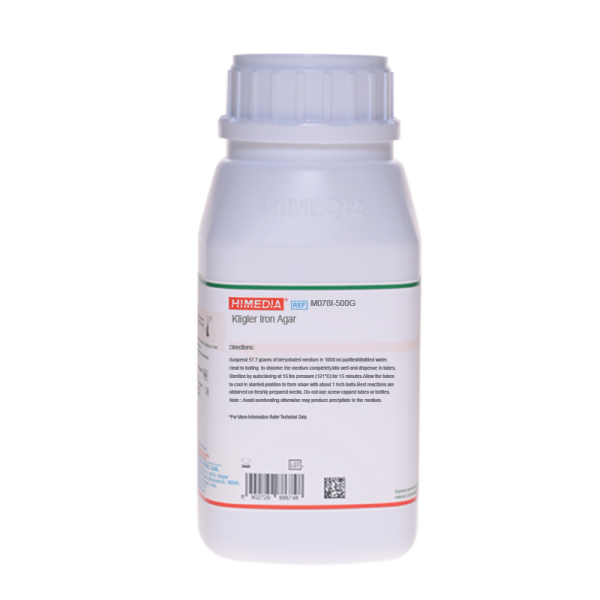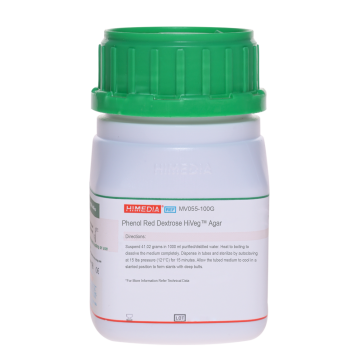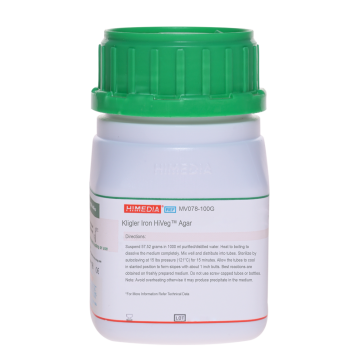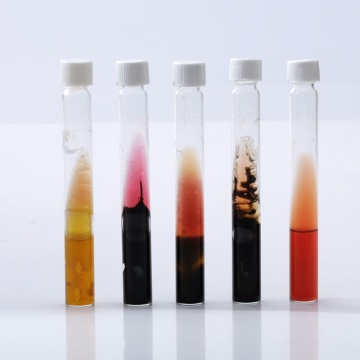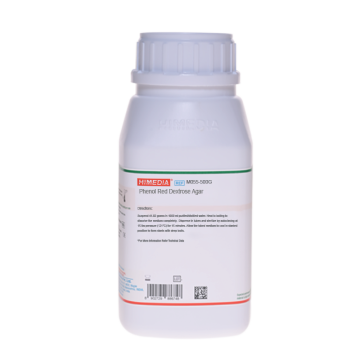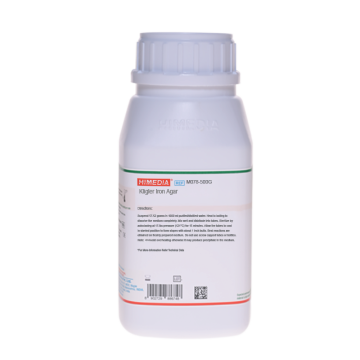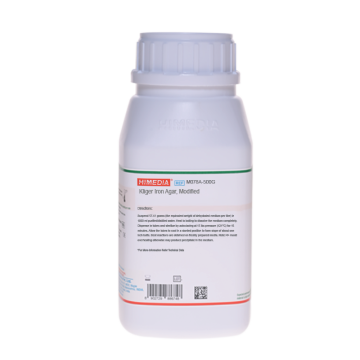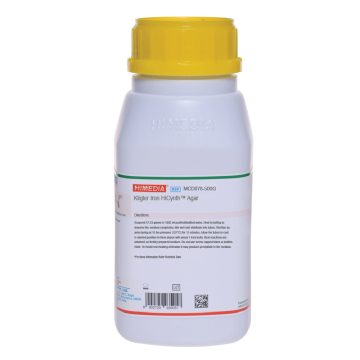 Your enquiry has been submitted
Your enquiry has been submitted
Kligler Iron Agar
Identification and Biochemical Characterization#CC293D
Intended Use
Recommended for identification of Pseudomonas species. It can be also used for differential identification of Gram-negative enteric bacilli. The composition and performance criteria of this medium are as per the specifications laid down in ISO 13720:2010.
Composition**
Ingredients
| Ingredients | Gms / Litre |
|---|---|
| HM peptone B # | 3.000 |
| Yeast extract | 3.000 |
| Tryptone | 20.000 |
| Sodium chloride | 5.000 |
| Lactose | 10.000 |
| Dextrose (Glucose) | 1.000 |
| Ferrous ammonium sulphate hexahydrate | 0.500 |
| Sodium thiosulphate pentahydrate | 0.500 |
| Phenol red | 0.025 |
| Agar | 15.000 |
Final pH (at 25°C) 7.4±0.2
**Formula adjusted, standardized to suit performance parameters
# Equivalent to beef extract
Directions
Suspend 57.7 grams of dehydrated medium in 1000 ml purified/distilled water. Heat to boiling to dissolve the medium completely. Mix well and dispense in tubes. Sterilize by autoclaving at 15 lbs pressure (121°C) for 15 minutes. Allow the tubes to cool in slanted position to form slope with about 1 inch butts. Best reactions are obtained on freshly prepared media. Do not use screw-capped tubes or bottles.
Note: Avoid overheating otherwise may produce precipitate in the medium.
Principle And Interpretation
Kligler Iron Agar is a combination of the lead acetate medium described by Kligler (1,2) and Russels Double Sugar Agar (2) and is used as a differentiation medium for typhoid, dysentery and allied bacilli (3). Bailey and Lacey substituted phenol red for andrade indicator previously used as pH indicator (4). Kligler Iron Agar differentiates lactose fermenters from the non-fermenters. It differentiates Salmonella Typhi from other Salmonella and also Salmonella Paratyphi A from Salmonella Scottmuelleri and Salmonella Enteritidis (5). Kligler Iron Agar is also recommended by ISO Committee for identification of Pseudomonas species (6). Fermentation of dextrose results in production of acid, which turns the indicator from red to yellow. Since there is little sugar i.e. dextrose, acid production is very limited and therefore a reoxidation of the indicator is produced on the surface of the medium, and the indicator remains red. However, when lactose is fermented, the large amount of acid produced, avoids reoxidation and therefore the entire medium turns yellow. Kligler Iron Agar, in addition to tryptone, HM peptone B and yeast extract, contains lactose and glucose (dextrose), which enables the differentiation of species of enteric bacilli. Phenol red is the pH indicator, which exhibits a colour change in response to acid produced during the fermentation of sugars. The combination of ferric ammonium sulphate and sodium thiosulphate enables the detection of hydrogen sulfide production, which is evidenced by a black color either throughout the butt, or in a ring formation near the top of the butt. Lactose non-fermenters (e.g. Salmonella and Shigella) initially produce a yellow slant due to acid produced by the fermentation of the small amount of glucose (dextrose). When glucose (dextrose) supply is exhausted in the aerobic environment of the slant, the reaction reverts to alkaline (red slant) due to oxidation of the acids produced. The reversion does not occur in the anaerobic environment of the butt, which therefore remains acidic (yellow butt). Lactose fermenters produce yellow slants and butts because of lactose fermentation. The high amount of acids thus produced helps to maintain an acidic pH under aerobic conditions. Tubes showing original colour of the medium indicates the fermentation of neither glucose (dextrose) nor lactose.
Type of specimen
Isolated microorganism from food samples.
Specimen Collection and Handling
For food samples, follow appropriate techniques for sample collection and processing as per guidelines (7).
After use, contaminated materials must be sterilized by autoclaving before discarding.
Warning and Precautions
Read the label before opening the container. Wear protective gloves/protective clothing/eye protection/face protection. Follow good microbiological lab practices while handling specimens and culture. Standard precautions as per established guidelines should be followed while handling specimens. Safety guidelines may be referred in individual safety data sheets.
Limitations
- Results should be noted after 18-24 hours. Else it might result in erroneous results.
- Straight wire loop should be used for inoculation.
- Pure isolates should be used to avoid erroneous results.
Performance and Evaluation
Performance of the medium is expected when used as per the direction on the label within the expiry period when stored at recommended temperature.
Quality Control
Appearance Light yellow to pink homogeneous free flowing powder
Gelling Firm, comparable with 1.5% Agar gel
Colour and Clarity of prepared medium Red coloured, clear to slightly opalescent gel forms in tubes as slants
Reaction Reaction of 5.77% w/v aqueous solution at 25°C. pH: 7.4±0.2
pH 7.20-7.60
Cultural Response
Cultural characteristics observed after an incubation at 35-37°C for 18-48 hours.
| Organism | Inoculum (CFU) | Growth | Slant | Butt | Gas | H2S |
|---|---|---|---|---|---|---|
| Escherichia coli ATCC 25922 (00013*) | 50-100 | luxuriant | acidic reaction, yellowing of the medium | acidic reaction, yellowing of the medium | positive reaction | negative reaction, no blackening of medium |
| Enterobacter cloacae ATCC 13047 (00083*) | 50-100 | luxuriant | acidic reaction, yellowing of the medium | acidic reaction, yellowing of the medium | positive reaction | negative reaction, no blackening of medium |
| Klebsiella pneumoniae ATCC 13883 (00097*) | 50-100 | luxuriant | acidic reaction, yellowing of the medium | acidic reaction, yellowing of the medium | positive reaction | negative reaction, no blackening of medium |
| Proteus vulgaris ATCC 6380 | 50-100 | luxuriant | alkaline reaction, red colour of the medium | acidic reaction, yellowing of the medium | negative reaction | positive reaction, blackening of medium |
| Pseudomonas aeruginosa ATCC 27853 (00025*) | 50-100 | luxuriant | alkaline reaction, red colour of the medium | acidic reaction, yellowing of the medium | negative reaction | negative reaction, no blackening of medium |
| Salmonella Typhi ATCC 6539 | 50-100 | luxuriant | alkaline reaction, red colour of the medium | acidic reaction, yellowing of the medium | negative reaction | positive reaction, blackening of medium |
| Salmonella Enteritidis ATCC 13076 (00030*) | 50-100 | luxuriant | alkaline reaction, red colour of the medium | acidic reaction, yellowing of the medium | positive reaction | positive reaction, blackening of medium |
| Shigella flexneri ATCC 12022 (00126*) | 50-100 | luxuriant | alkaline reaction, red colour of the medium | acidic reaction, yellowing of the medium | negative reaction | negative reaction, no blackening of medium |
| Yersinia enterocolitica ATCC 27729 | 50-100 | luxuriant | alkaline reaction, red colour of the medium | acidic reaction, yellowing of the medium | variable reaction | negative reaction, no blackening of medium |
| # Klebsiella aerogenes ATCC 13048 (00175*) | 50-100 | luxuriant | acidic reaction, yellowing of the medium | acidic reaction, yellowing of the medium | positive reaction | negative reaction, no blackening of medium |
| Salmonella Paratyphi A ATCC 9150 | 50-100 | luxuriant | alkaline reaction, red colour of the medium | acidic reaction, yellowing of the medium | positive reaction | negative reaction, no blackening of medium |
| Salmonella Schottmuelleri ATCC 10719 | 50-100 | luxuriant | alkaline reaction, red colour of the medium | acidic reaction, yellowing of the medium | positive reaction | positive reaction, blackening of medium |
| Citrobacter freundii ATCC 8090 | 50-100 | luxuriant | acidic reaction, yellowing of the medium | acidic reaction, yellowing of the medium | positive reaction | positive reaction, blackening of medium |
Key: (*) Corresponding WDCM numbers. (#) Formerly known as Enterobacter aerogenes
Storage and Shelf Life
Store between 10-30°C in a tightly closed container and the prepared medium at 20-30°C. Use before expiry date on the label. On opening, product should be properly stored dry, after tightly capping the bottle in order to prevent lump formation due to the hygroscopic nature of the product. Improper storage of the product may lead to lump formation. Store in dry ventilated area protected from extremes of temperature and sources of ignition Seal the container tightly after use. Product performance is best if used within stated expiry period.
Disposal
User must ensure safe disposal by autoclaving and/or incineration of used or unusable preparations of this product. Follow established laboratory procedures in disposing of infectious materials and material that comes into contact with sample must be decontaminated and disposed of in accordance with current laboratory techniques (8,9).
Reference
- Kligler I. J., 1917, Am. J. Publ. Health, 7:1041.
- Kligler I. J., 1918, J. Exp. Med., 28:319.
- Russell F. F., 1911, J. Med. Res., 25:217.
- Bailey S. F. and Lacey G. R., 1927, J. Bacteriol., 13:183.
- Ewing, 1986, Edwards and Ewings Identification of the Enterobacteriaceae, 4th Ed., Elsevier Science Publishing Co., Inc., N.Y.
- International Organization for Standardization (ISO), 2010, Draft ISO/DIS 13720.
- Salfinger Y., and Tortorello M.L. Fifth (Ed.), 2015, Compendium of Methods for the Microbiological Examination of Foods, American Public Health Association, Washington, D.C.
- Isenberg, H.D. Clinical Microbiology Procedures Handbook 2nd Edition.
- Jorgensen, J.H., Pfaller, M.A., Carroll, K.C., Funke, G., Landry, M.L., Richter, S.S and Warnock., D.W. (2015) Manual of Clinical Microbiology, 11th Edition. Vol. .1
| Product Name | Kligler Iron Agar |
|---|---|
| SKU | M078I |
| Product Type | Regular |
| Physical Form | Powder |
| Origin | Animal |
| Packaging type | HDPE |
| References | 1.Russell F. F., 1911, J. Med. Res., 25:217. 2.Kligler I. J., 1917, Am. J. Publ. Health, 7:1041. 3.Kligler I. J., 1918, J. Exp. Med., 28:319. 4.Bailey S. F. and Lacey G. R., 1927, J. Bacteriol., 13:183. 5.Ewing, 1986, Edwards and Ewings Identification of the Enterobacteriaceae, 4th Ed., Elsevier Science Publishing Co., Inc.,N.Y. 6.American Public Health Association, Standard Methods for the Examination of Dairy Products, 1978, 14th Ed.,Washington D.C. 7.Downes F. P. and Ito K., (Ed.), 2001, Compendium of Methods for the Microbiological Examination of Foods, 4th Ed.,American Public Health Association, Washington, D.C. 8.Isenberg, H.D. Clinical Microbiology Procedures Handbook. 2nd Edition. 9.Jorgensen,J.H., Pfaller , M.A., Carroll, K.C., Funke, G., Landry, M.L., Richter, S.S and Warnock., D.W. (2015) Manual ofClinical Microbiology, 11th Edition. Vol. 1.10.Wehr H. M. and Frank J. H., 2004, Standard Methods for the Microbiological Examination of Dairy Products, 17thEd.,APHA Inc., Washington, D.C |
| Customized Product Available | No |



